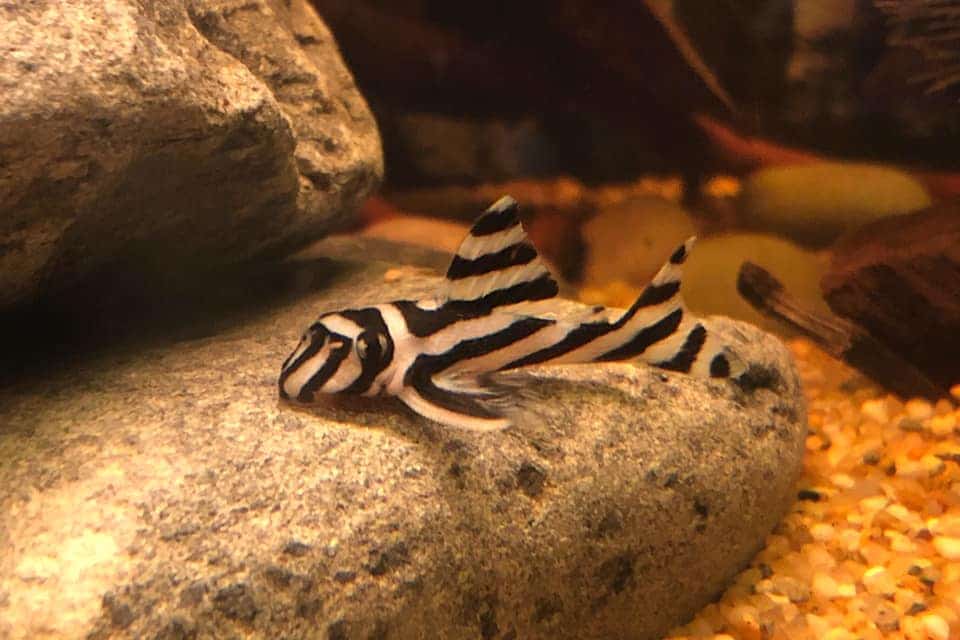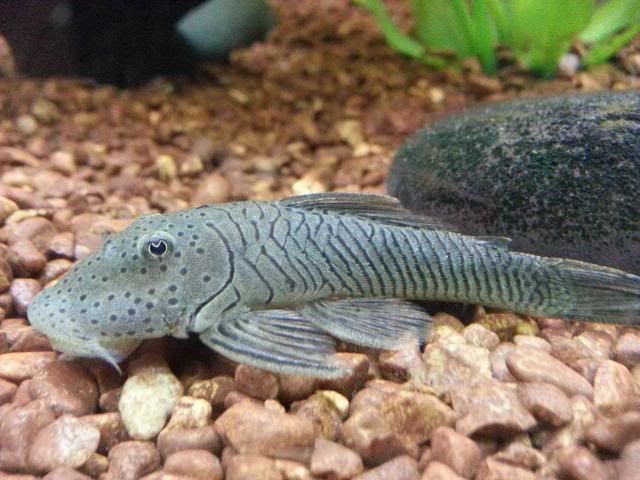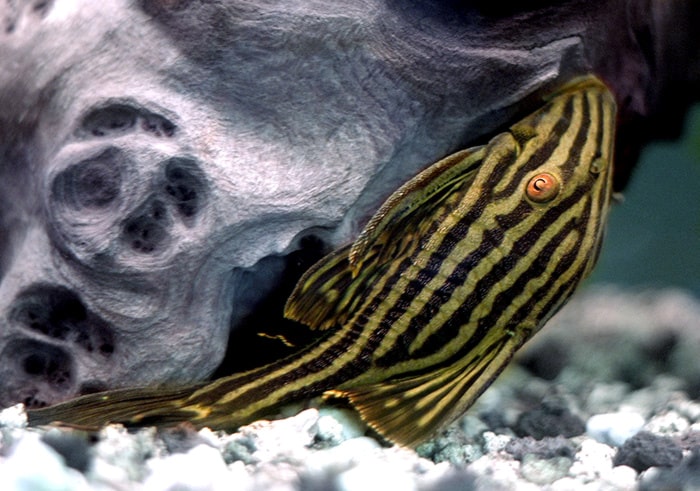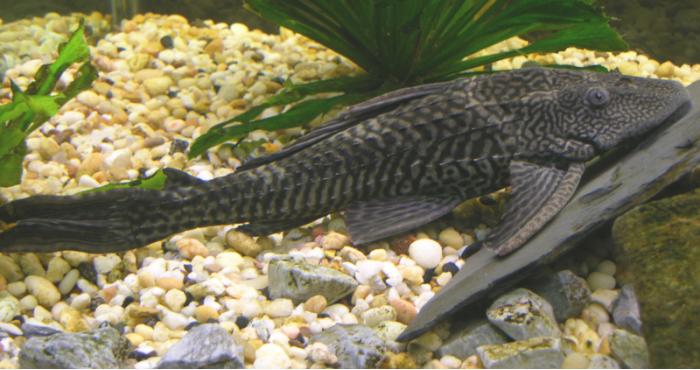Plecos are extremely popular among aquarists all over the world, whether they are beginners or experts. If you ask why it’s because they’re easy to care for (most of them, at least), calm, and can help you clean the tank. There are many types of plecos and each of them has its own uniqueness.
Each pleco fish comes in various sizes, colors, and patterns that you can choose from. But before you decide to get a pleco, the first question is what types of plecos are best for your fish tank (especially if you are new to this hobby)?
Choosing plecos might be confusing (sometimes) due to character differences on each pleco species. But don’t worry, we’ll give you some sneak peek of their basic needs. And most importantly, the types of plecos you might want to get. If you’re curious about it, just keep reading!
Table of Contents
Plecos Natural Habitat
Most Plecostomus is originally from South American areas where the water is relatively warm. Several types of plecos acquire only some narrow specific area, but the majority can be found in a wide range of rivers.
In their natural habitat, most plecos live in shallow rivers or streams with fast-moving water. Although, some live in acidic black water or brackish water. The water where they inhabit usually has many plants and driftwood. They tend to hide during the day because they are nocturnal by nature.
Typical Behavior
The Plecostosmus are generally peaceful fish. But they are also territorial. They will not hesitate to fight or harass any fish that trespass their territory. If you want to house them in a community tank, it’s better to get fish that swims on the surfaces.
As it has been mentioned earlier, plecos are nocturnal. So you won’t see them swimming around in the morning or afternoon. During that time, they will be resting in between the plants or caves in the tank.
You can see the plecos start their activities after the sun is down. They move slowly, as they are slow-swimmers. At this time, they begin to work, which is eating the algae.
Water Conditions
Plecos inhabit soft waters with a rather low pH level in their natural environment. But they are hardy and adaptive fish that can tolerate diverse water conditions.
Ideal water temperature between 74°F to 80°F with a pH level ranging from 7 to 8 will be suitable for plecos. We recommend using a heater if you keep the tank in a room with a temperature below 74°F.
Don’t forget to change the water to maintain good quality. You can change 10% every week or 25% every two weeks.
But depending on the types of plecos you want to keep, they might require different water parameters. So it’s best to do your research first before you get one.
11 Most Common Types of Plecos
Apparently, there are more than 150 species of plecos that have been discovered. But the bad news is, not all of those species are suitable for your home aquarium.
Yes, they are freshwater fish that are easy to care for. However, their size range is incredibly diverse.
If you know little to nothing about plecos before getting them, you might end up with an enormous giant fish in your tank. Seriously, one species could reach the length of 2 feet (or even more). But no worries, here we provide you suggestions on which plecos you could keep. Check them out!
1. Zebra pleco (Hypancistrus zebra)

- Size: 3.5 inches
- Care level: Intermediate
- Diet: Omnivore
- Minimum tank size: 20 gallons
- Lifespan: 10 to 15 years
As their name suggests, this pleco just like a zebra in a fish form. Their striking appearance makes a lot of aquarists seek them.
But in contrast to their look, this fish is timid and doesn’t like much attention. You will often find them hiding during the day since they are nocturnal and more active at night.
The zebra pleco is also very peaceful, so you can keep them with other species of similar characteristics.
As for feeding, you can give them frozen foods or shrimp pellets. Although, it’s better to feed the zebra plecos with live foods like bloodworms and brine shrimp.
Unlike other species in their family, this pleco does not eat algae. So don’t expect them to clean the tank for you. You can only keep them solely because of their display.
2. Bristlenose pleco (Ancistrus cirrhosus)

- Size: 3-5 inches
- Care level: Easy
- Diet: Omnivore (more inclined to herbivore)
- Minimum tank size: 40 gallons
- Lifespan: up to 12 years
This bristlenose gained its name from the tentacles that develop on their face. The tentacles are more evident on the males than it is on females. This type of pleco is probably the most common pleco species among aquarists. That’s because they are small and easy to care for.
Bristlenose pleco is hardy, peaceful, and friendly. They can adapt to a wide range of water conditions and can be kept in a community tank.
Besides, they come in varieties of color bases and dots. Which makes them an excellent addition to your tank’s aesthetics.
The bristlenose are omnivores. So feeding them algae wafers, spirulina, or small live foods like bloodworms (occasionally) will do. They’re also great algae eaters, which will help you keep your tank clean.
3. Gold nugget pleco (Baryancistrus xanthellus)

- Size: 7-10 inches
- Care level: Intermediate
- Diet: Omnivore
- Minimum tank size: 75 gallons
- Lifespan: 3 to 7 years
This is another eye-catching type of pleco. Their bodies have a black color base and are covered with bright small yellow dots. You can also see yellow stripes on the tips of their dorsal fin and tail.
The gold nugget pleco is relatively peaceful, even though some aggression might occur between the males.
It’s best to keep them with tankmates that swim on the surfaces. That will keep your tank structure balanced since this pleco usually hangs out on the bottom of the tank.
The gold nugget pleco is not a fussy eater. They will eat anything you give them. A combination of meaty and plant matter foods will help balance their diet. Therefore, you can feed them sinking pellets and live foods like bloodworms or tubifex.
4. Rubber lip pleco (Chaetostoma milesi)

- Size: 5-7 inches
- Care level: Intermediate
- Diet: Omnivore
- Minimum tank size: 30 gallons
- Lifespan: 10 to 12 years
The rubber lip pleco is perhaps not very famous compared to the other types of this species. But still, it is a beautiful fish and available in many different colors and patterns.
Another quality of this pleco is they are quite peaceful. Although they are not aggressive, it’s not common to house them with other plecos. It’s best to keep them with other peaceful tankmates or with their own kind.
The rubber lip pleco is known as “tank maid” because they eat the algae that grow in the tank. But tank’s algae will not satisfy their need for nutrition. You need to feed them algae wafers and supplement them with meaty food as well.
5. Sailfin pleco (Pterygoplichthys gibbiceps)

- Size: 12-19 inches
- Care level: Easy-Intermediate
- Diet: Omnivore
- Minimum tank size: 100 gallons
- Lifespan: 15 to 20 years
Just like its name, this type of pleco got a stunning dorsal fin that looks like a sail. Their armored scales and leopard-like pattern add to the uniqueness of this pleco.
The sailfin pleco is more active at night and hides away during the daytime. You can provide them some caves or driftwoods to hide. They also prefer to stay at the bottom of the tank. You can fill your aquarium with sandy substrate or gravel.
To maintain a healthy diet, you need to feed them a wide variety of food. Don’t worry because they are not picky eaters. Sinking pellets, plant matter, and meaty foods are ideal. Also, make sure to feed them twice a day.
6. Royal pleco (Panaque nigrolineatus)

- Size: 17 inches
- Care level: Easy-Intermediate
- Diet: Herbivore
- Minimum tank size: 100 gallons
- Lifespan: 10 years
Royal pleco is fairly large in size. Their base color is usually light brown, and on top of that, they got uneven dark brown or black stripes. Besides, their striking red eyes also make them more particular.
They blend in very easily with various wood logs in the aquarium where they feed due to their coloration.
The royal pleco is pretty territorial by nature, and they can get a bit aggressive. They will find an area in the tank and stay there. But surprisingly, this fish is also very shy.
This fish has an easy diet. They will eat the algae that grow in the tank. But due to their size, just eating the algae will never be enough for them. In that case, you can provide them sinking pellets, wafers, or other algae-based foods.
7. Common pleco (Pterygoplichthys pardalis)

- Size: 18-24 inches
- Care level: Intermediate
- Diet: Herbivore
- Minimum tank size: 100 gallons
- Lifespan: 10 to 15 years
This type of pleco is one of the most common among fishkeepers. It is also one of the biggest among other types.
But some fishkeepers or aquarists are not aware of that. This is sad because some people actually tried to house them in tanks smaller than 100 gallons. That’s absolutely not good for the fish’s growth, knowing that they grow rather rapidly.
Common pleco is known as an algae eater because they feed on the in-tank-grown algae. They also accept sinking algae, shrimp pellets, or wafers.
8. Snowball pleco (Hypancistrus inspector)

- Size: 5.5-6.5 inches
- Care level: Easy
- Diet: Omnivore
- Minimum tank size: 40-50 gallons
- Lifespan: 8 to 10 years
Snowball pleco looks similar to the gold nugget pleco, but they are different. Snowball pleco usually have grey or black base color, while the males are usually more reddish-brown. Their bodies are covered with tiny white (or light yellow) dots that resemble snowballs. That explains how they got their name.
This fish is docile and unaggressive. But it is best not to keep them with other bottom-swimmers, as they will fight for hiding places.
The snowball pleco is not a picky eater. In fact, you need to give them a wide variety of food. That includes dried, frozen, or live foods such as Daphnia, shrimp, mosquito larvae, and bloodworms. They even eat the leftovers on the bottom!
9. Vampire pleco (Leporacanthicus galaxias)

- Size: 8-10 inches
- Care level: Intermediate
- Diet: Carnivore
- Minimum tank size: 50 gallons
- Lifespan: 5 to 8 years
Also referred to as galaxy pleco, this fish resembles the night sky full of stars. They are dark-colored, mostly black or grey as the base color, and covered with white or yellow dots.
Besides their stunning look, they’re also known to be peaceful. They will do great in a community tank. However, some records say that the vampire pleco can be territorial. You can only keep them with other calm fish.
As a carnivore, they do not eat the algae in the aquarium. Therefore, you can feed them live foods such as shrimp or snails.
10. Sunshine pleco (Scobinancistrus aureatus)

- Size: 12 inches
- Care level: Intermediate
- Diet: Omnivore
- Minimum tank size: 100 gallons
- Lifespan: 8 to 10 years
Unlike other plecos that are more neutral or dark-colored, the sunshine pleco is distinctly vibrant. That’s because their brown or black base color is densely covered with orange spots. It’s no wonder why they’re quite popular among fish keepers.
This gorgeous fish is on the timid side and very docile. But like many other plecos, it’s better to separate them from other bottom-dwellers. The reason is predictable. They can get territorial and fight over hiding spots.
Sunshine pleco is an omnivore, and their diet is pretty simple. They will eat everything you provide them. Besides, they are also great algae eaters to keep your tank clean.
11. Butterfly pleco (Dekeyseria picta)

- Size: 5-6 inches
- Care level: Easy
- Diet: Herbivore
- Minimum tank size: 60 gallons
- Lifespan: 5 to 8 years
Butterfly pleco is different from other fish of the genus. It is due to their ability to camouflage! Their bodies are black with uneven vibrant yellow stripes.
But if kept in a tank with a dark substrate or dark setup, they will easily alter their color and instantly become completely black.
The butterfly pleco is a herbivore and eats a healthy diet. You can feed them wafers, veggies, and live foods occasionally. They also eat algae that help keep the water quality. Just like many other plecos, the butterfly pleco is nocturnal and needs safe places to hide from lights. Thus, some driftwoods or plants are essential for them.
Which types of plecos are best for you?
There are so many varieties of plecos, fight? And each of them is unique in its own way.
The most important thing to consider before you’re getting a pleco is probably the tank size you can provide. If you have a smaller tank, you can get a zebra pleco or bristlenose pleco.
Or if you’re more into bigger fish, that’s also cool. You can keep larger plecos like the common pleco or the royal one. So which types of plecos are you getting?






